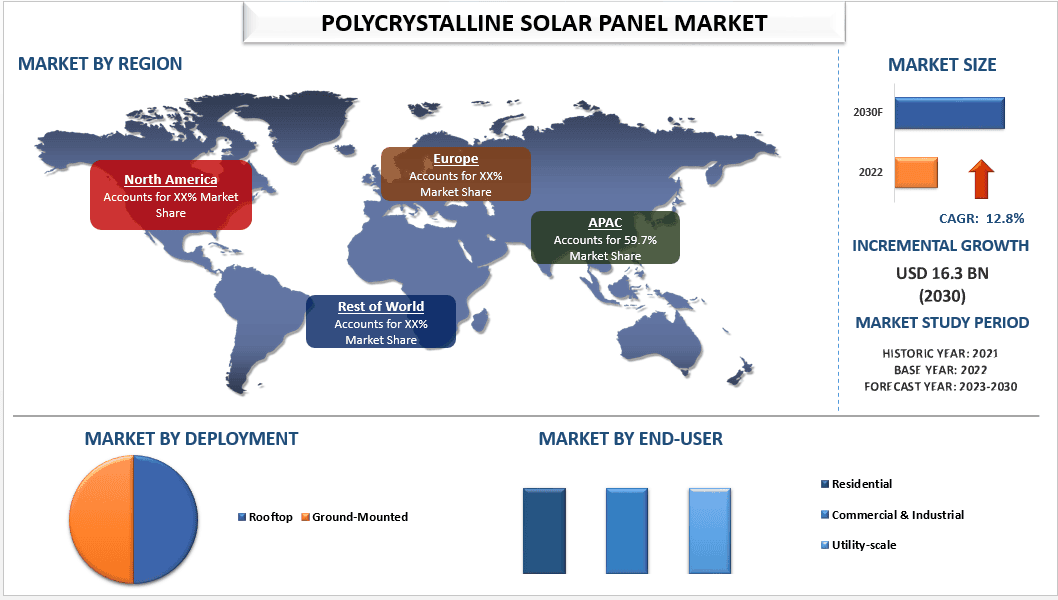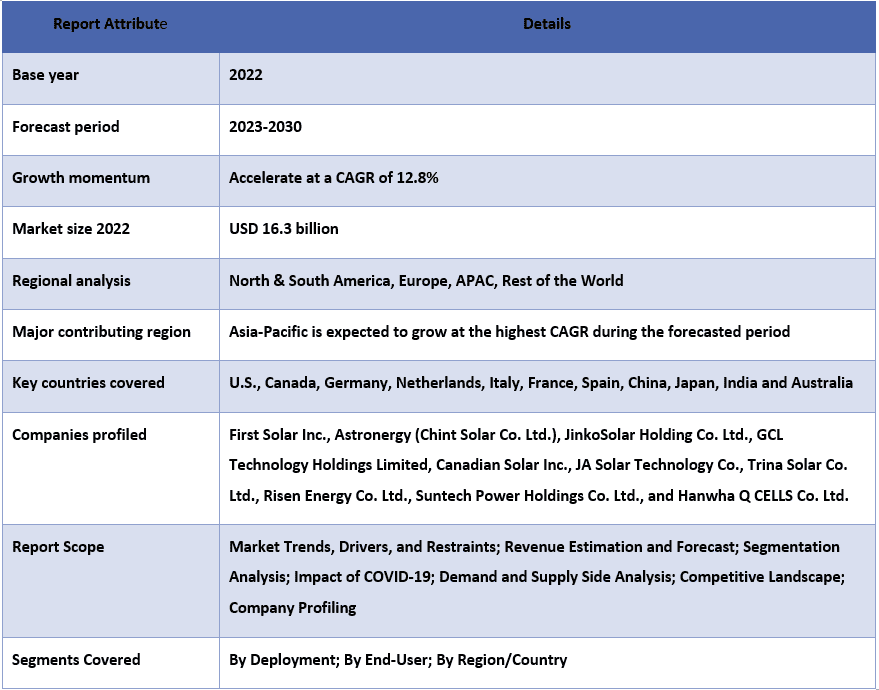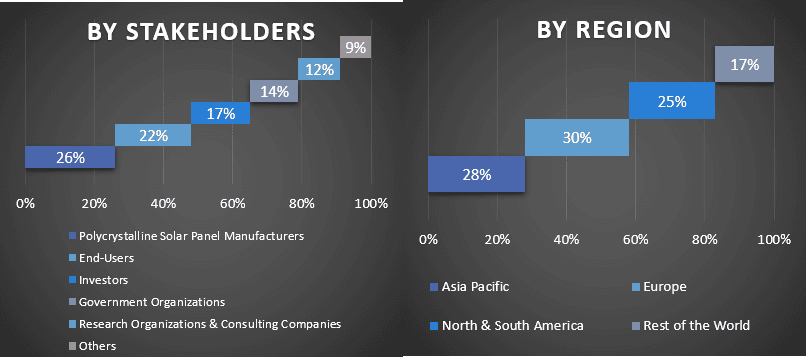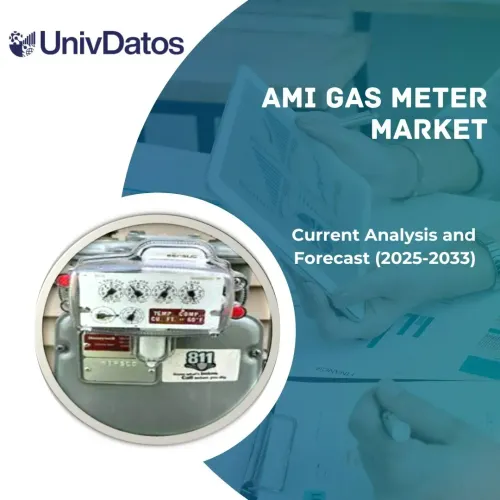Рынок поликристаллических солнечных панелей: текущий анализ и прогноз (2023-2030)
Акцент на развертывании (на крыше и на земле); Применение (жилое, коммерческое и промышленное, а также коммунальное); Регион/Страна.

Объем глобального рынка поликристаллических солнечных панелей в 2022 году оценивался в 16,3 млрд долларов США, а среднегодовой темп роста (CAGR) в прогнозируемый период с 2023 по 2030 год составит 12,8%, и к 2030 году достигнет 42,9 млрд долларов США. Поликристаллические солнечные панели, также известные как мультикристаллические панели, представляют собой тип солнечных панелей, которые состоят из множества кристаллов кремния в каждой фотоэлектрической (PV) ячейке. Эти модули изготавливаются путем расплавления кусков кремния и заливки их в формы для образования солнечных элементов (также называемых "пластинами"). Затем элементы располагаются рядами и столбцами, образуя солнечную панель. Поликристаллические солнечные панели широко используются в бытовых солнечных системах из-за их доступности и эффективности. Они могут преобразовывать в электричество 16-18% солнечного света, попадающего на них. Хотя поликристаллические панели менее эффективны, чем монокристаллические, они часто дешевле, что делает их популярными среди многих домовладельцев.
Более того, необходимость достижения целей по нулевым выбросам в различных странах мира и повышение осведомленности потребителей об экологически чистой энергии выступают в качестве катализатора роста глобального рынка поликристаллических солнечных панелей в течение прогнозируемого периода. Для достижения целей, установленных политикой Net Zero Emissions 2050, выработка солнечной энергии должна расти со среднегодовым темпом роста (CAGR) 25% в период с 2022 по 2030 год.
В 2021 году выработка солнечной энергии увеличилась на 22%, на 179 ТВтч, превысив общий объем в 1000 ТВтч. Солнечная энергия является одним из самых недорогих в мире вариантов производства электроэнергии. На долю солнечной энергии приходится почти 3,6% мирового производства электроэнергии, и она является третьей по величине технологией возобновляемой электроэнергии после ветровой и гидроэнергетики. Страны по всему миру активно инвестируют в возобновляемые источники энергии для достижения своих целей в области возобновляемой энергетики. Рынок солнечной энергии является одним из основных источников энергии, который пережил огромный бум в последнее десятилетие. Например, в США, одной из ведущих стран в области солнечной энергетики, солнечная энергетика демонстрировала средний годовой темп роста в 33% только за последнее десятилетие. Благодаря сильной федеральной политике, такой как Налоговый кредит на инвестиции в солнечную энергетику, быстрому снижению затрат и растущему спросу на чистую электроэнергию в частном и государственном секторах, по всей стране установлено более 140 гигаватт солнечных мощностей, что достаточно для обеспечения электроэнергией 25 миллионов домов.
Некоторые из основных игроков, работающих на рынке, включают First Solar Inc., Astronergy (Chint Solar Co. Ltd.), JinkoSolar Holding Co. Ltd., GCL Technology Holdings Limited, Canadian Solar Inc., JA Solar Technology Co., Trina Solar Co. Ltd., Risen Energy Co. Ltd., Suntech Power Holdings Co. Ltd. и Hanwha Q CELLS Co. Ltd. Этими игроками было предпринято несколько слияний и поглощений, а также партнерств, чтобы предоставить клиентам высокотехнологичные и инновационные продукты/технологии.
Информация, представленная в отчете
"Среди вариантов развертывания, категория крыш занимала доминирующую долю рынка в 2022 году"
В зависимости от развертывания, рынок поликристаллических солнечных панелей подразделяется на сегменты крыш и наземных установок. Сегмент крыш приобрел большую долю на рынке поликристаллических солнечных панелей и, как ожидается, продемонстрирует значительный темп роста в течение прогнозируемого периода. Крышная фотоэлектрическая система означает фотоэлектрическую систему, в которой установлены солнечные панели, генерирующие электроэнергию, на крыше здания или сооружения. Большинство крышных фотоэлектрических систем, как правило, являются жилыми и намного меньше по сравнению с наземными солнечными системами коммунального масштаба. Большинство жилых крышных фотоэлектрических систем находятся в диапазоне 5-20 кВт, в то время как коммерческие системы, установленные на крышах, могут варьироваться от 100 кВт до 1 МВт. На многих больших крышах построены фотоэлектрические системы промышленного масштаба в диапазоне 10 МВт.
Обзор отчета о рынке поликристаллических солнечных панелей

"Среди конечных пользователей, категория коммунального масштаба занимала доминирующую долю рынка в 2022 году"
В зависимости от применения, рынок поликристаллических солнечных панелей подразделяется на сегменты жилых, коммерческих и промышленных объектов, а также коммунального масштаба. Сегмент коммунального масштаба приобрел большую долю на рынке поликристаллических солнечных панелей и, как ожидается, продемонстрирует значительный темп роста в течение прогнозируемого периода. Фотоэлектрические установки коммунального масштаба остаются самым конкурентоспособным источником фотоэлектрической генерации в мире; однако строительство крупномасштабных установок становится все более сложной задачей во многих регионах мира из-за нехватки подходящих площадок. Более того, солнечная энергия является основным выбором для частного сектора, если они хотят инвестировать в возобновляемые источники энергии. Компании, инвестирующие в распределенные (включая крышные) солнечные фотоэлектрические установки на своих коммерческих зданиях и предприятиях, отвечают примерно за 30% от общей установленной фотоэлектрической мощности, кроме того, Компании заключают корпоративные соглашения о покупке электроэнергии с операторами солнечных фотоэлектрических станций, что будет стимулировать рынок поликристаллических солнечных панелей в течение прогнозируемого периода.
"В 2022 году в Азиатско-Тихоокеанском регионе была зарегистрирована доминирующая доля рынка"
В Азиатско-Тихоокеанском регионе была зарегистрирована самая высокая доля рынка поликристаллических солнечных панелей, и ожидается, что в прогнозируемый период он станет свидетелем влиятельного среднегодового темпа роста (CAGR). Это в основном связано с многочисленными проектами в области солнечных фотоэлектрических (PV) элементов, реализуемыми в Китае, Индии, Австралии и Японии. Более того, благоприятная государственная политика, правила и инвестиции в достижение целей в области возобновляемой энергетики, установленных различными странами, стимулируют рынок. Например: В Австралии правительство Австралии предоставит 14 миллионов австралийских долларов для поддержки стратегического проекта технологических инноваций компании 5B стоимостью 33,4 миллиона австралийских долларов через Австралийское агентство возобновляемой энергетики; В Японии правительство Японии выделило 8 миллиардов иен в национальном бюджете на 2021 год для поддержки внедрения независимого оборудования для производства солнечной энергии и накопительных батарей, включая электромобили, посредством PPA на месте; а в Индии правительство Индии объявило о дополнительном вливании капитала в размере 10 миллиардов рупий в Корпорацию солнечной энергии Индии и 15 миллиардов рупий в Индийское агентство по развитию возобновляемой энергетики.
Причины купить этот отчет:
- Исследование включает анализ размеров рынка и прогнозирование, подтвержденный аутентифицированными ключевыми экспертами отрасли.
- В отчете представлен краткий обзор общих показателей отрасли с первого взгляда.
- Отчет охватывает углубленный анализ видных представителей отрасли с основным упором на ключевые финансовые показатели бизнеса, портфели продуктов, стратегии расширения и последние разработки.
- Подробное изучение движущих сил, ограничений, ключевых тенденций и возможностей, преобладающих в отрасли.
- Исследование всесторонне охватывает рынок по различным сегментам.
- Углубленный анализ отрасли на региональном уровне.
Варианты настройки:
Глобальный рынок поликристаллических солнечных панелей может быть дополнительно настроен в соответствии с требованиями или любым другим сегментом рынка. Кроме того, UMI понимает, что у вас могут быть свои собственные бизнес-потребности, поэтому не стесняйтесь связаться с нами, чтобы получить отчет, который полностью соответствует вашим требованиям.
Содержание
Методология исследования для анализа рынка поликристаллических солнечных панелей (2023-2030 гг.)
Анализ исторического рынка, оценка текущего рынка и прогнозирование будущего рынка глобального рынка поликристаллических солнечных панелей были тремя основными шагами, предпринятыми для создания и анализа внедрения поликристаллических солнечных панелей в основных регионах мира. Было проведено исчерпывающее вторичное исследование для сбора данных об историческом рынке и оценки текущего размера рынка. Во-вторых, для подтверждения этих выводов было принято во внимание множество результатов и предположений. Кроме того, были проведены исчерпывающие первичные интервью с отраслевыми экспертами по всей цепочке создания стоимости глобального рынка поликристаллических солнечных панелей. После предположения и проверки рыночных показателей посредством первичных интервью мы применили подход «сверху вниз/снизу вверх» для прогнозирования полного размера рынка. После этого были приняты методы разбивки рынка и триангуляции данных для оценки и анализа размера рынка сегментов и подсегментов отрасли. Подробная методология описана ниже:
Анализ исторического размера рынка
Шаг 1: Углубленное изучение вторичных источников:
Было проведено детальное вторичное исследование для получения данных об историческом размере рынка поликристаллических солнечных панелей из внутренних источников компании, таких как годовые отчеты и финансовая отчетность, презентации о деятельности, пресс-релизы и т. д., и внешних источников, включая журналы, новости и статьи, правительственные публикации, публикации конкурентов, отраслевые отчеты, сторонние базы данных и другие надежные публикации.
Шаг 2: Сегментация рынка:
После получения данных об историческом размере рынка поликристаллических солнечных панелей мы провели детальный вторичный анализ для сбора исторических рыночных данных и доли различных сегментов и подсегментов для основных регионов. Основные сегменты, включенные в отчет, включают Развертывание и Конечный пользователь. Был проведен дальнейший анализ на уровне стран для оценки общего внедрения моделей тестирования в этом регионе.
Шаг 3: Факторный анализ:
После получения данных об историческом размере рынка различных сегментов и подсегментов мы провели подробный факторный анализ для оценки текущего размера рынка поликристаллических солнечных панелей. Кроме того, мы провели факторный анализ с использованием зависимых и независимых переменных, таких как Развертывание и Конечный пользователь рынка поликристаллических солнечных панелей. Был проведен тщательный анализ сценариев спроса и предложения с учетом ведущих партнерств, слияний и поглощений, расширения бизнеса и запуска продуктов в секторе рынка поликристаллических солнечных панелей по всему миру.
Оценка текущего размера рынка и прогноз
Определение текущего размера рынка: На основе практически применимых данных, полученных в результате вышеуказанных 3 шагов, мы определили текущий размер рынка, ключевых игроков на глобальном рынке поликристаллических солнечных панелей и доли рынка сегментов. Все необходимые процентные доли разделения и разбивки рынка были определены с использованием вышеупомянутого вторичного подхода и были проверены посредством первичных интервью.
Оценка и прогнозирование: Для оценки и прогнозирования рынка различным факторам были присвоены веса, включая движущие силы и тенденции, ограничения и возможности, доступные для заинтересованных сторон. После анализа этих факторов были применены соответствующие методы прогнозирования, т. е. подход «сверху вниз/снизу вверх», чтобы получить прогноз рынка на 2030 год для различных сегментов и подсегментов на основных рынках по всему миру. Методология исследования, принятая для оценки размера рынка, включает в себя:
- Размер рынка отрасли в денежном выражении (доллары США) и уровень внедрения рынка поликристаллических солнечных панелей на основных рынках внутри страны
- Все процентные доли, разделения и разбивки сегментов и подсегментов рынка
- Ключевые игроки на глобальном рынке поликристаллических солнечных панелей с точки зрения предлагаемых продуктов. Кроме того, стратегии роста, принятые этими игроками для конкуренции на быстрорастущем рынке
Подтверждение размера рынка и доли
Первичное исследование: Были проведены углубленные интервью с ключевыми лидерами мнений (KOL), включая руководителей высшего звена (CXO/вице-президенты, руководители отделов продаж, руководители отделов маркетинга, руководители операционных отделов, региональные руководители, главы стран и т. д.) в основных регионах. Затем были обобщены результаты первичных исследований и проведен статистический анализ для доказательства заявленной гипотезы. Вклад, полученный в результате первичных исследований, был объединен с результатами вторичных исследований, что превратило информацию в практически применимые знания.
Разделение первичных участников по различным регионам

Инженерия рынка
Метод триангуляции данных был использован для завершения общей оценки рынка и получения точных статистических данных для каждого сегмента и подсегмента глобального рынка поликристаллических солнечных панелей. Данные были разделены на несколько сегментов и подсегментов после изучения различных параметров и тенденций в областях Развертывания и Конечного пользователя на глобальном рынке поликристаллических солнечных панелей.
Основная цель исследования глобального рынка поликристаллических солнечных панелей
В исследовании были точно определены текущие и будущие рыночные тенденции глобального рынка поликристаллических солнечных панелей. Инвесторы могут получить стратегические знания, на которых можно основывать свои решения для инвестиций, на основе качественного и количественного анализа, проведенного в исследовании. Текущие и будущие рыночные тенденции определили общую привлекательность рынка на региональном уровне, предоставив промышленному участнику платформу для использования неиспользованного рынка, чтобы воспользоваться преимуществом первопроходца. Другие количественные цели исследований включают:
- Анализ текущего и прогнозного размера рынка поликристаллических солнечных панелей в денежном выражении (доллары США). Кроме того, анализ текущего и прогнозного размера рынка различных сегментов и подсегментов
- Сегменты в исследовании включают области Развертывания и Конечного пользователя
- Определение и анализ нормативно-правовой базы для индустрии поликристаллических солнечных панелей
- Анализ цепочки создания стоимости с участием различных посредников, а также анализ поведения клиентов и конкурентов в отрасли
- Анализ текущего и прогнозного размера рынка поликристаллических солнечных панелей для основного региона
- Основные страны регионов, исследованные в отчете, включают Азиатско-Тихоокеанский регион, Европу, Северную и Южную Америку и остальной мир
- Профили компаний на рынке поликристаллических солнечных панелей и стратегии роста, принятые участниками рынка для поддержания устойчивости на быстрорастущем рынке
- Углубленный анализ отрасли на региональном уровне
Связанные Отчеты
Клиенты, купившие этот товар, также купили










